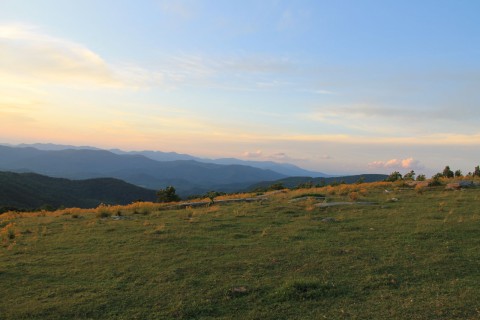Long before the age of Internet lists and online travel magazines, people came to Asheville and Western North Carolina for the intrinsic natural beauty — diverse wildlife, clean air, lush forests, clear waters, ancient mountains and one of the world’s oldest rivers, the French Broad.
The beauty of our environment is what many say makes this place so special. But are we protecting what we have? What initiatives are underway to help ensure that the region remains a respite and a haven for generations to come?
Water

Rivers have been key to the development and survival of many cities, but getting people to understand their importance hasn’t always been easy. The story of the French Broad is one of transformation and survival. Karen Cragnolin, executive director of RiverLink, describes the evolution of Asheville’s waterfront — from a thriving business and community center wiped out by a flood in 1916 to a semi-deserted warehouse district and polluted waterway in the mid-20th century. Today though, the waterfront is home to the bustling River Arts District, which draws both visitors and residents to popular restaurants and studio tours.
Cragnolin credits the river’s economic and environmental renewal to the writings of local activist Wilma Dykeman in the 1950s and the continued work of residents, activists and groups like RiverLink, which launched in 1989. Cragnolin says RiverLink’s work to restore the environmental and recreational health of the river is ongoing. “We realized this was a 60-year project,” she adds.
Today, almost halfway into the grand vision, several projects have taken shape on the river. Part of the revival has included cleanups and pollution controls that improved water quality and increased public access through green spaces like Carrier Park, French Broad River Park and the 1.2 miles of greenway along the banks of the river and throughout the RAD. In September 2014, the city received a $14.6 million grant for its RAD improvement plan, which will go toward building the 2.2-mile Wilma Dykeman Riverway, developed in partnership with RiverLink. When completed, the new section will link 17 miles of trails along the French Broad and Swannanoa rivers. A visitor or resident could “get on a greenway at Broadway and go all the way to the arboretum without having to get on a road,” Cragnolin says.
But the future health of the French Broad will hinge on much more than outdoor recreation. A serious concern, Cragnolin emphasizes, is the need to figure out how — if at all — our water will be shared with other parts of WNC and the state, as population pressures, climate change and other factors lead to water shortages. She notes that local water suppliers like the city of Asheville already have agreements with neighboring municipalities, towns and counties for interbasin transfers — agreements to take water from one area and provide for another that doesn’t have enough for its populace.
Water sharing will be “a huge issue in the future,” Cragnolin says, adding that, “We haven’t established the rules on how we share it.” Current legislation allows N.C.’s governor to call for interbasin transfers as an emergency measure, and Cragnolin notes that such transfers have already occurred for areas of the French Broad when Henderson County transferred water to Polk County.
“How do we decide, as a watershed entity, who gets our water? Do we want anyone to get it?” Cragnolin asks. “We’ve got to figure this out.”
Air

The Canary Coalition formed in 1999 specifically to address deteriorating air quality in the mountains. At that time, “it was becoming very clear that this region was subject to some of the worst air pollution in the country,” says Avram Friedman, executive director of the Sylva-based nonprofit.
Research by the National Park Service, which began tracking air pollution in the 1980s, demonstrated how bad things were, he recalls. “We weren’t fully aware of the extent of which coal was a part of air pollution,” Friedman says.
The mountains were acting as a net, catching and holding coal-based pollution from neighboring states as well as from within. Vehicular traffic also added to the problem, with ground-level ozone posing the biggest challenge: It drifts upward at night and settles at altitudes between 2,000 and 6,000 feet above sea level — the elevation ranges in the Appalachians. Inhaled ozone can lead to lung inflammation, and Friedman says this effect was evident in some of WNC’s youngest residents.
“There was this terrible asthma epidemic [in the late 1990s], especially among children,” he explains. “One in three children were suffering from asthma in WNC. It was the largest cause of school absenteeism, and [a] huge health and economic issue.”
The Canary Coalition gathered support across the region and pushed state legislators to establish the Clean Smokestacks Act in 2002. The act required significant emissions reductions from coal-fired power plants — 77 percent for nitrogen oxide emissions by 2009 and 73 percent for sulfur dioxide emissions by 2013.
“We got calls from the Jackson County Chamber of Commerce, the medical community, the local newspaper, the travel and tourism bureau. They all endorsed our efforts,” Friedman says.
Following the adoption of the act and the implementation of pollution controls, air quality improved in the region and in some ways exceeded the hopes of the bill, says Ashley Featherstone, permitting program manager with WNC Regional Air Quality Agency. “We’ve seen improvements here in Buncombe County and across the state,” Featherstone says. She cites a 90 percent reduction in sulfur dioxide emissions at Duke Energy’s Asheville plant since pollution-control scrubbers were installed in 2005-2006.
That said, there’s still more to be done, Friedman notes. The coalition has recently lobbied the General Assembly to pass legislation that would incorporate an inverted rate structure into utility billing, giving residents and businesses an incentive to use less energy.
Inverted rates are based on a tier system where customers who use more energy are charged higher rates, and customers who use less energy are charged lower rates, Friedman explains. Currently, electricity has a set rate no matter how much is used.
The Canary Coalition says this measure would both lower energy costs and potentially reduce energy use — cutting emissions from power plants and further improving air quality. The proposed legislation also calls for the creation of an energy efficiency “bank” — an independent agency that manages the finances of utility bills and issues low-interest loans for energy-efficienct projects. Repayment of loans would be integrated into the monthly utility bill, Friedman explains.
Friedman adds that other states have begun using inverted rates, including New Mexico and Colorado. One benefit would be “massive reductions in consumption [because] this is a major shift in energy policy and the economics of energy,” Friedman says.
To date, the bill has now been introduced three times, without success, but Friedman remains optimistic. “In the 2013 session we had a total of 15 legislators who sponsored or co-sponsored the bill,” he says. “Our goal is to increase that number in [the current] session.”
Earth

Land conservancy has long been a huge part of economic and environmental sustainability as well.
In 1966, a group of recreation buffs and hikers sought to protect the balds at Roan Mountain, an area beloved for its sweeping mountain views and unique natural habitat. That group, originally known as the Roan Mountain Preservation Committee, grew to become the Southern Appalachian Highlands Conservancy, which works to preserve the high country in Mitchell and Avery counties — an area SAHC director Carl Silverstein notes is “astonishingly beautiful.”
More recently, in 1994, the Carolina Mountain Land Conservancy was born from a survey commissioned by Henderson County’s League of Women Voters to assess the county’s natural areas. “It was made apparent that some of those special places were in danger of being lost — if they hadn’t been lost already,” says Kieran Roe, CMLC’s executive director. The nonprofit primarily focuses on Henderson County and surrounding areas, including Hickory Nut Gorge.
Combined, these two groups have protected more than 100,000 acres in the region through conservation easements, purchases and transfers to state and federal parks.
But Silverstein points out that conservation isn’t just about preventing development — it’s about saving WNC’s most special places. Eligible lands have to hit certain criteria, he explains — including government guidelines that evaluate an area’s rare plants, streams, forest cover and views.
Once an area has been identified, both state and federal park officials work with the conservancies in efforts to extend park boundaries and protect viewsheds. In many cases, a local trust will hold the land until the government agency can afford to buy it at a reduced rate. This transfer/assist method has accounted for vast extensions of protected land in Hickory Nut Gorge, at Chimney Rock Park, along the Appalachian Trail and in the Great Smoky Mountains National Park.
For SAHC, this method has been used for 46 percent of the land the organization has placed into conservation. In the case of easements facilitated by CMLC, Roe says part of the popularity is that land held for generations gets to stay in the family. “People like it,” Roe says. “They get to keep their land, but they’re assured that it will always remain relatively undeveloped.”
The easements are enforced into perpetuity and come with very significant tax incentives, leading many landowners to actively seek out the trusts, Roe adds. “When the Great Recession hit, people were going bankrupt who owned large tracts of land they borrowed money on. We were being approached by landowners who had no other option, saying, ‘Will you buy my land?’” Roe says.
Roe mentions that former U.S. Rep. Charles Taylor — for many years the single largest private landowner in Transylvania county — is working with CMLC to place 8,000 acres into a conservation easement. The tract boasts high-quality water, rare plants and animals and intact forests — and will likely become North Carolina’s newest state forest.
Silverstein adds that conservation easements are also used to protect farmland. With only 2 percent of the land in WNC considered prime for agriculture and many farms disappearing, easements allow farmers to maintain ownership and decrease cost burdens due to tax incentives — all while continuing to work the land.
He adds that Buncombe County — “a hero among counties in the state” — provides some funding that leverages easement purchases and “helps get these transactions done.”
“Our colleagues in other counties look at us with envy,” Silverstein says. “It’s a real model for public-private partnership.”
In the heart of the city
At the end of the day, almost all conservation issues come down to public policy — and in recent years, a lot has happened at the local level. In 2007, the city of Asheville created the Sustainability Advisory Committee of Energy and Environment, hiring a full-time employee to oversee the work.
“In 2008, we started benchmarking the city’s performance based on greenhouse gas emissions,” says Kerby Smithson, interim sustainability manager for the city. “[We’ve] made a lot of improvements on our fleet vehicles, as far as using alternative fuels, [and our] streetlights, which we’re replacing with LED lights that last much longer and use half as much energy, as well as having zero uplight [light pollution].”
The city has also focused on employee responsibility in its facilities — reminding staff to turn off lights and computers, for example. Those same facilities are also slowly switching to a highly automated heating-and-cooling system that could be run by one person from a laptop — allowing that person to turn off the systems when buildings are unoccupied and also keep temperatures within a 10-degree range when occupied.
The city is also reaching out to residents as part of what Smith- son terms “community-facing sustainability initiatives.” Some examples include the introduction of the blue recycling bins in 2012 as a single-stream system that eliminated the need to separate the material. City staff is also analyzing ways to reduce solid waste, possibly in the form of a “pay-as-you-throw” initiative.
One unmitigated success, he says, is the city’s carbon footprint. “[The city] council mandated an annual 4 percent carbon footprint reduction in 2011 [up from 2 percent in 2008], and we’ve been meeting that every year,” Smithson says. Energy spending across city facilities, he adds, has decreased by $400,000 since 2012.
So how are we doing?
Despite all of this, there remains much work to be done.
For land trusts, money and time are always a concern. By the time enough money is raised to buy a tract, it may have been sold to a developer. And cuts in state funding have been difficult to surmount, says Silverstein, forcing increased reliance on private funding.
Roe adds that the effects of the recent real estate boom and sub- sequent market crash also influence conservation efforts. “People were buying land and doing developments and subdividing property because it was the way to make a fast buck, [but] no one intended to stay there,” he says. As an example, he points to the failed Seven Falls luxury development in Henderson County, “where development should never have occurred and the land was ruined.”
Still, community awareness of the advantages of sustainability and preservation — especially in the economic sense — have helped put Asheville and the region on the map, Roe says. “Businesses are moving here for the quality of life,” he explains. “They want to be in a place where the employees have access to the wonderful outdoor amenities we have around here.”
The recent brewery boom, he points out, is the perfect example as that industry relies on natural resources — in this case, clean water — in order to even function. “It’s no coincidence that Sierra Nevada is located right on the French Broad,” Roe says. “People in the region are coming to realize that natural resources are not an impediment to our economic boom — they’re the assets upon which our future economic development will be based.”
And those natural resources draw people here, to stay or to visit, and make the area one of a kind. Cragnolin adds that the mountains have always had a unique sense of presence. If anything will keep the region viable, she says, it will be embracing that: “Celebrate who you are and what you are. Don’t try to be somewhere else; it just won’t work.”



Before you comment
The comments section is here to provide a platform for civil dialogue on the issues we face together as a local community. Xpress is committed to offering this platform for all voices, but when the tone of the discussion gets nasty or strays off topic, we believe many people choose not to participate. Xpress editors are determined to moderate comments to ensure a constructive interchange is maintained. All comments judged not to be in keeping with the spirit of civil discourse will be removed and repeat violators will be banned. See here for our terms of service. Thank you for being part of this effort to promote respectful discussion.